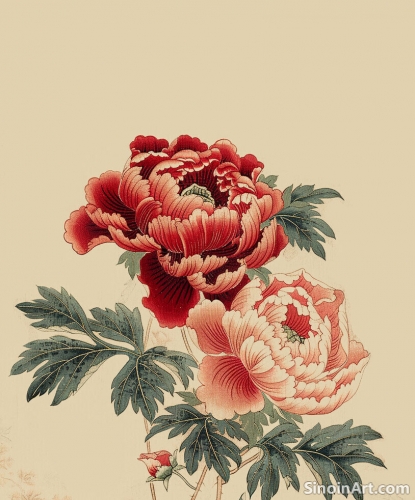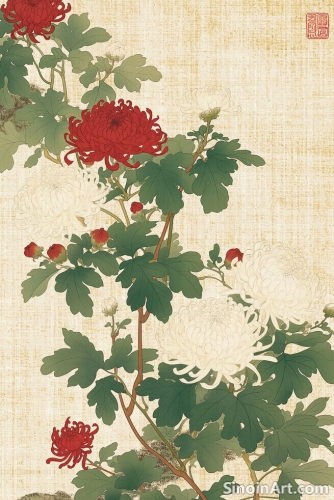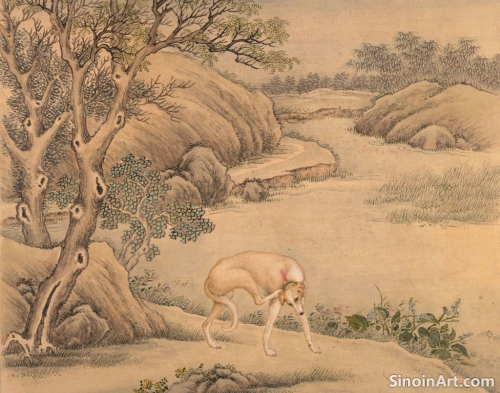Gongbi Landscapes: Capturing the Spirit of Nature
|
While often associated with flower and bird paintings, Gongbi is also used to create stunning landscape artworks. Unlike the expressive style of freehand landscape painting (xieyi), Gongbi landscapes are characterized by their meticulous detail, precise rendering, and rich color palettes. These paintings capture not only the visual appearance of nature but also its underlying spirit and essence.  The focus on precision in Gongbi landscape extends to every element of the scene. Mountains, rocks, trees, and water are rendered with meticulous detail, capturing their specific characteristics and forms. This requires a keen eye for observation and a deep understanding of the underlying structure and texture of each element. Each aspect of the natural environment is given careful attention.  The use of traditional brushstrokes and techniques is central to Gongbi landscape painting. The "gougou" method, the outlining of every element, forms the foundation of the artwork. Subtle washes of color are layered to create depth and atmosphere. Each brushstroke is purposeful and deliberate, contributing to the overall harmony and balance of the composition. This careful application of technique gives the work a sense of realism.  Symbolism plays a significant role in Gongbi landscape paintings. Mountains are often depicted as symbols of stability and longevity, while water is associated with the flow of time and transformation. Specific plants, like pine trees and bamboo, also hold symbolic meanings, adding depth and meaning to the scene. Artists utilize this symbolic language to convey philosophical ideas. Gongbi landscape paintings often convey a sense of peace and harmony. They are not just records of natural scenery; they also invite viewers to contemplate their place within the larger universe. The meticulous detail and balanced composition create a visual space that is both captivating and serene. These paintings capture the essence of the natural world and create a space for contemplation. |
Tag : Gongbi landscape, Chinese landscape painting, traditional landscape art, nature in art, meticulous landscapes
Related information
- The Use of Gold Leaf and Other Embellishments in Gongbi
- Gongbi and the Use of Bird Motifs: Symbolism and Beauty
- Symbolism in Gongbi Painting: Reading the Language of Detail
- Gongbi and the Depiction of Mythological Figures
- The Symbolism of Gongbi: Decoding the Language of the Brush
This article explores the use of gold leaf and other embellishments in Gongbi painting, detailing their application, symbolic significance, and contribution to the visual richness and overall aesthetic of the artwork.
The depiction of birds is a prominent theme in Chinese Gongbi painting, often serving as a means to explore the beauty, freedom, and symbolic richness of the natural world. Artists often render a diverse array of birds, from majestic eagles and phoenixes to the more humble songbirds, imbuing them with specific cultural meanings and stylistic characteristics. The birds add a vibrant and often symbolic element to these pieces.
Gongbi painting is not only a visual art but also a rich tapestry of symbolic meanings, where the careful selection and rendering of subjects, colors, and compositional elements serve to convey specific messages and cultural values. The meticulous detail, characteristic of the style, enhances the symbolic weight of each object, transforming a seemingly realistic depiction into a complex visual language. This symbolic richness adds layers of meaning to the artistry of Gongbi painting.
This article explores the depiction of mythological figures in Gongbi painting, highlighting the symbolic attributes, use of color, intricate narratives, and how this art form brings to life the gods, immortals, and heroes of Chinese folklore.
This article explores the symbolic elements found in Gongbi paintings, focusing on the meanings behind flowers, animals, colors, and compositions within the Chinese artistic tradition.